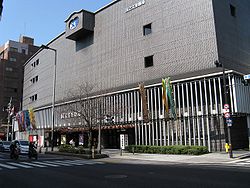
National Bunraku Theatre
Encyclopedia

Chuo-ku, Osaka
, Osaka is one of 24 wards of Osaka, Japan. It has an area of 8.88 km2, and a population of 60,085. It houses Osaka's financial district, as well as the Osaka Prefecture offices and principal shopping and tourist areas.-Diplomatic missions:...
, Osaka
Osaka
is a city in the Kansai region of Japan's main island of Honshu, a designated city under the Local Autonomy Law, the capital city of Osaka Prefecture and also the biggest part of Keihanshin area, which is represented by three major cities of Japan, Kyoto, Osaka and Kobe...
, Japan
Japan
Japan is an island nation in East Asia. Located in the Pacific Ocean, it lies to the east of the Sea of Japan, China, North Korea, South Korea and Russia, stretching from the Sea of Okhotsk in the north to the East China Sea and Taiwan in the south...
. The complex was opened in 1984 as the fourth national theatre of the country, to become the headquarters of bunraku
Bunraku
, also known as Ningyō jōruri , is a form of traditional Japanese puppet theater, founded in Osaka in 1684.Three kinds of performers take part in a bunraku performance:* Ningyōtsukai or Ningyōzukai—puppeteers* Tayū—the chanters* Shamisen players...
. The Japan Arts Council, an Independent Administrative Institution
Independent Administrative Institution
An Incorporated Administrative Agency or in lay terms an Independent Administrative Corporation or Independent Administrative Institution is a newly designed type of legal body for Japanese governmental organizations regulated by the Basic Law on Reforming Government Ministries of 1998...
of the Ministry of Education, Culture, Sports, Science and Technology
Ministry of Education, Culture, Sports, Science and Technology (Japan)
The , also known as MEXT or Monkashō, is one of the ministries of the Japanese government.The Meiji government created the first Ministry of Education in 1871....
, operates the National Theatre.
Outline
The theatre has two halls. The Large Theatre has a capacity of around 700 seats depending on stage setup, and is primarily used for performances of bunrakuBunraku
, also known as Ningyō jōruri , is a form of traditional Japanese puppet theater, founded in Osaka in 1684.Three kinds of performers take part in a bunraku performance:* Ningyōtsukai or Ningyōzukai—puppeteers* Tayū—the chanters* Shamisen players...
, as well as Buyō
Buyo
or is a traditional Japanese performing art, a mixture of dance and pantomime.- Japanese classical dance :******-Video:* * Japanese Dance * *...
and stage plays. In the Small Hall are performed other type of traditional arts such as , rakugo
Rakugo
is a Japanese verbal entertainment. The lone sits on the stage, called the . Using only a paper fan and a small cloth as props, and without standing up from the seiza sitting position, the rakugo artist depicts a long and complicated comical story...
, manzai
Manzai
is a traditional style of stand-up comedy in Japanese culture, which usually involves two performers —a straight man and a funny man —trading jokes at great speed...
and Japanese music.
External links
- National Theatre of Japan official site (in English)

